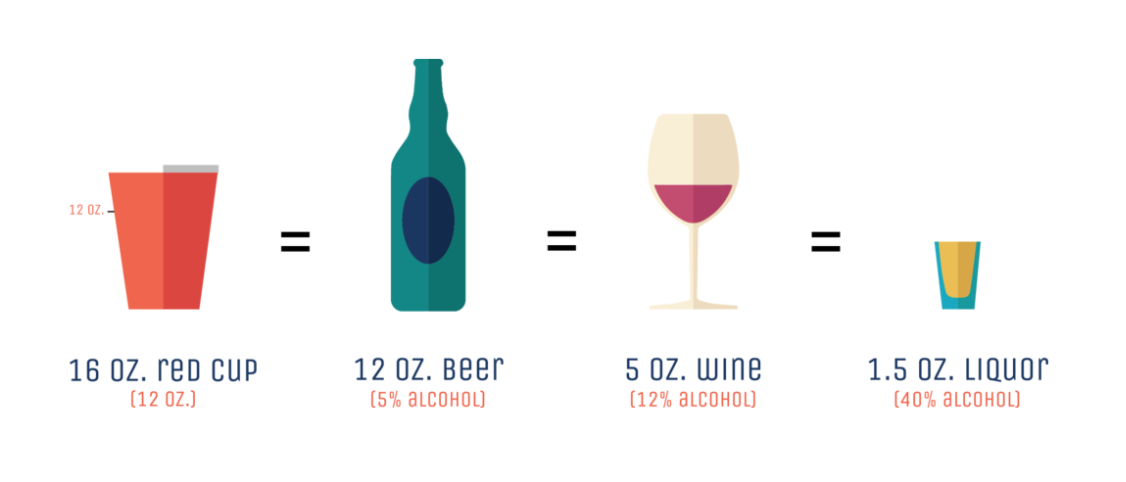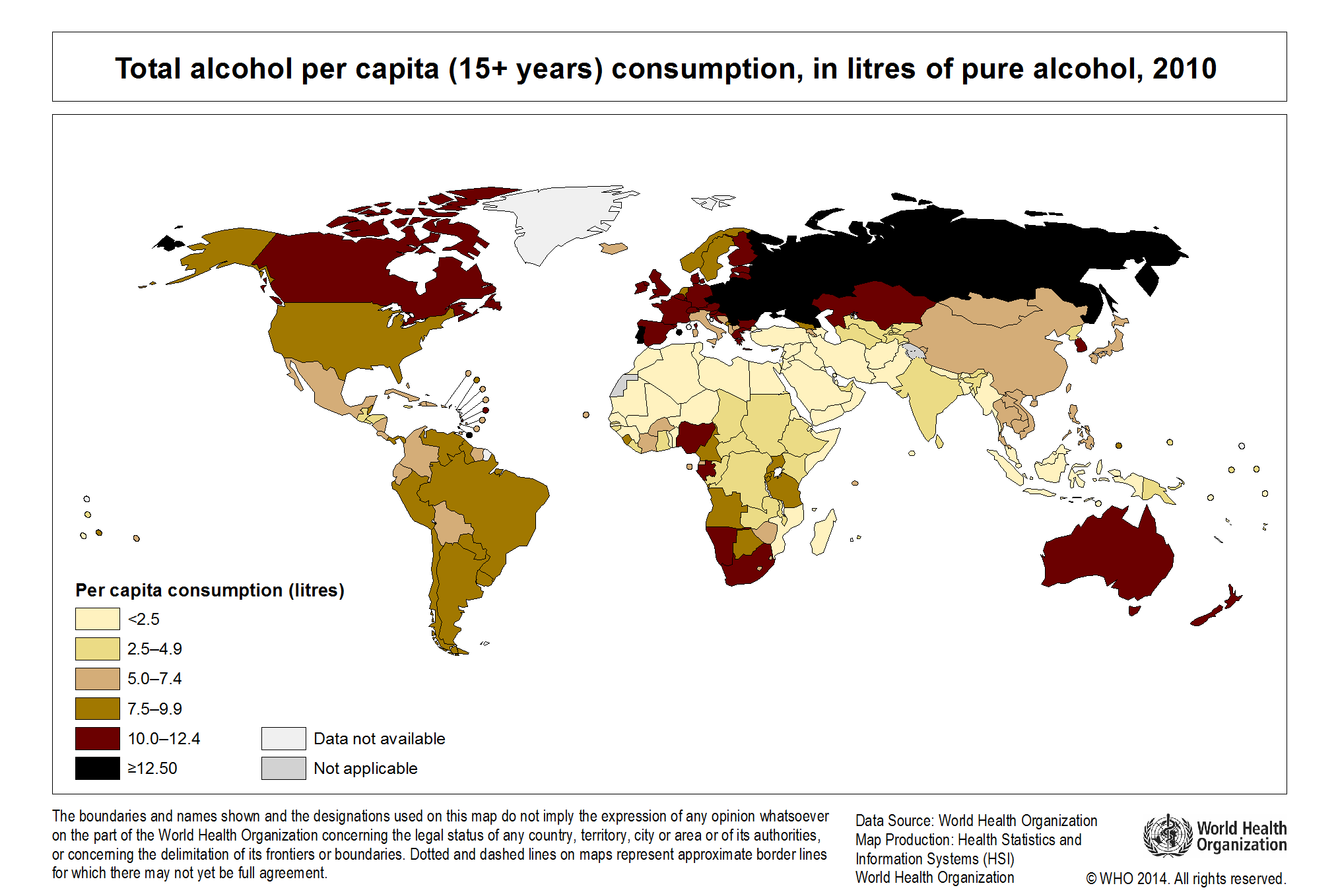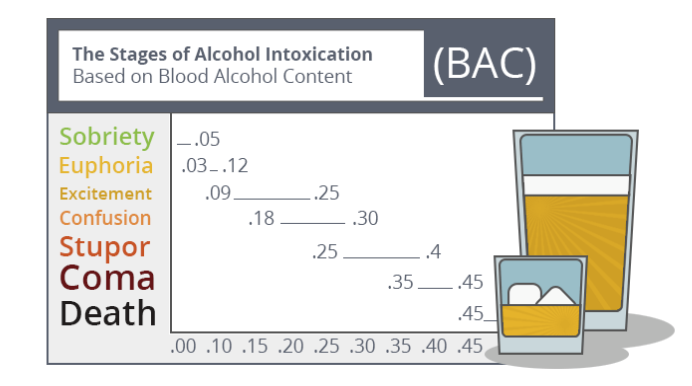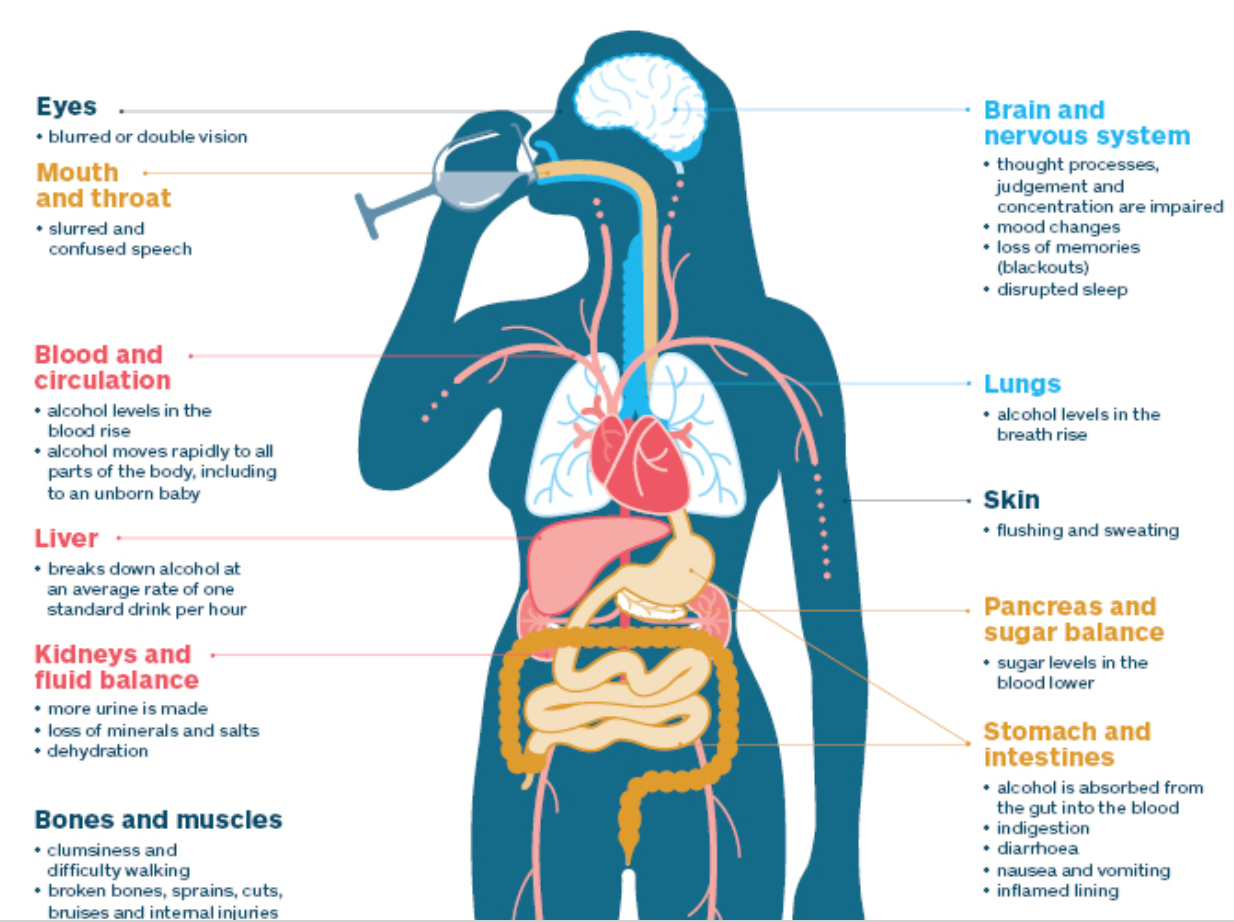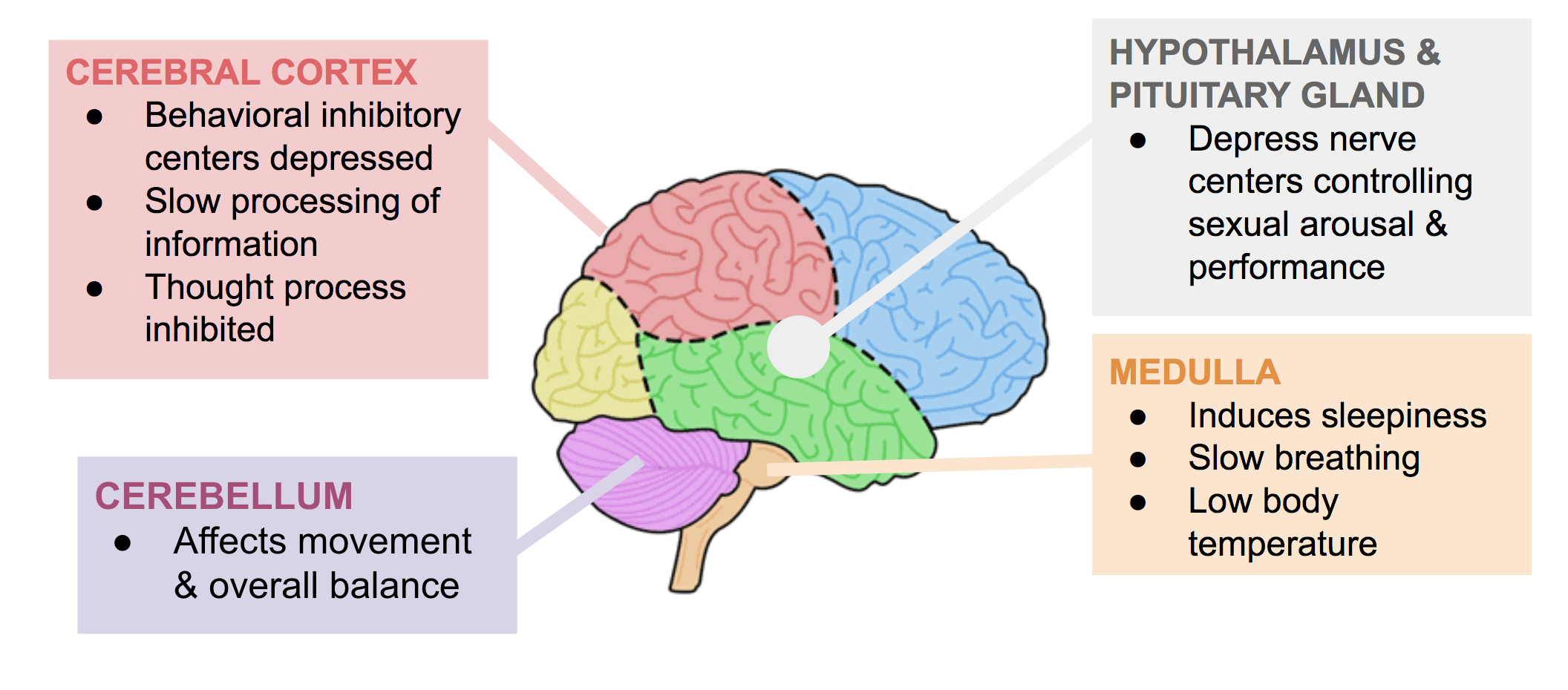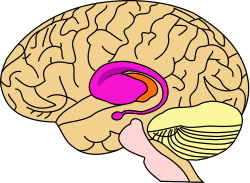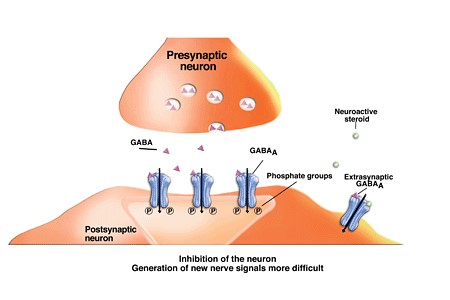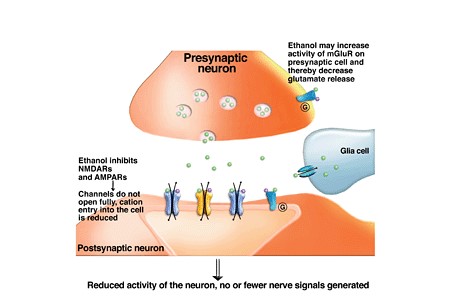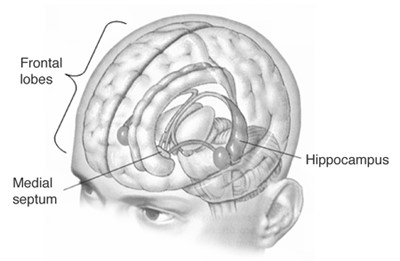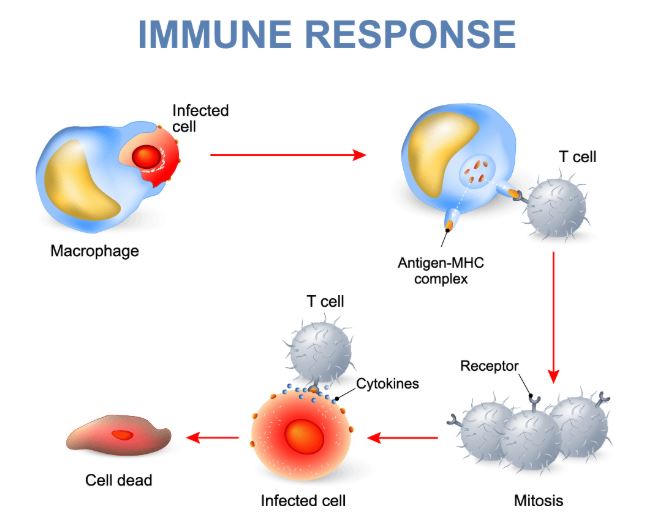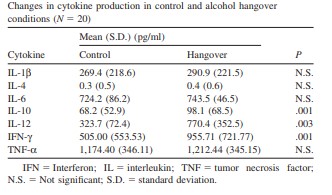Table of Contents
Alcohol Consumption
Beverages such as beer, wine and spirits contain the major ingredient alcohol, also known ethanol or ethyl alcohol, in its consumable form (What is alcohol, 2018). It is formed from a fermentation process involving yeast or bacteria breaking down certain sugars in the absence of oxygen. In specifics, wine is made from the sugar in grapes, beer from the sugar in malted barley (a type of grain) as well as rye, cider from the sugar in apples, vodka from the sugar in potatoes, beets or root plants (What is alcohol, 2018). After the fermentation process, the by-products include ethanol and carbon dioxide, which increases based on how long the sugars are left to ferment (What is alcohol, 2018). Certain spirits also undergo an additional distillation process, in which a portion of water is removed to allow a stronger concentration of alcohol and flavour to be created (What is alcohol, 2018).
Based on a study by NIH (2017), a standard drink is:
- 16oz red solo cup (12oz of alcohol)
- 12 ounce beer (5% alcohol by volume)
- 5 ounce glass of wine (12% alcohol by volume)
- 1.5 ounce shot of hard liquor (40% alcohol)
The prevalence of alcohol consumption around the world, based on the 2015 National Survey on Drug Use and Health (NSDUH), stated that 86.4% of people in the world ages 18 and above reported that they drank alcohol at some point in their life, while 70.15% reported that they drank alcohol in the past year, and 56.0% reported that they drank within in the recent month (NIH, 2017). Reports have also been conducted on the number of people that binge drink, which is a pattern of drinking that leaves the blood alcohol concentration (BAC) to 0.08g/dL consistently, as well as reports on heavy alcohol use, defined as binge drinking 5 or more days in a month (NIH, 2017). Thus it has been noted that 26.9% reported that they engaged in binge drinking in the recent month, while 7.0% reported that they engaged in heavy alcohol use in the recent month (NIH, 2017). Globally it has been seen that Russia, Portugal, Grenada and Andorra are ranked the highest in alcohol consumption, with Russia ranked highest, at more than 12.5 liters per person over the age of 15 as of 2010 (Boseley, 2016). Breaking that down further, between males and females it has been noted that men drink relatively more than women, however as of late women have been quickly catching up to the amount of alcohol they consume (Federation, 2011). It has been suggested however by the U.S. Department of Health and Human Services and U.S. Department of Agriculture, that moderate drinking for women should be up to 1 drink per day up to 2 drinks per day for men (NIA, 2018). Yet it also has been noted that for the average man, alcohol consumption is at about 13 drinks per week, with age of drinking peaking at 25 years old, while women peaked at 4 drinks per week (Boseley, 2016).
The "Drunk" Phase
The alcohol found with these beverages cause the known feelings of “drunkenness.” Drunkenness occurs when a large proportion of alcohol enters one’s system and bloodstream at the same time, causing many physical and mental symptoms to result dependent of level of blood alcohol concentration (BAC) levels (What are the, 2018). BAC is defined as the percent of blood that is concentrated with alcohol. For instance, a BAC of 0.10g/dL means that 0.1% of your blood is comprised of alcohol (What are the, 2018). A further explanation of BAC levels can be found below in Figure 3.
Drunk Physiology
Alcohol is also known as a sedative hypnotic drug based on its ability to depress the central nervous system at high levels. At low levels though, alcohol can act as a stimulant to allow feelings of talkativeness and euphoria and eventual drowsiness and respiratory depression as consumption continues (What is alcohol, 2018). Alcohol is first process in the liver where it is responsible for detoxifying and removing the alcohol from the blood. The time it takes for your liver to absorb and metabolize the alcohol in the liver actually depends on the alcoholic content of the drink and other factors such as if you have eaten (What happened when, 2018). A standard drink however can be metabolized between every 60-90 minutes (What happened when, 2018). When your liver is unable to keep up with you consumption of alcoholic drinks, the central nervous system can become depressed and the rest of the unmetabolized alcohol goes to other parts of the body (What happened when, 2018).
From a top-down perspective of the body, a drinker’s eyes can become blurred and vision can become severely impaired. Their speech can slur and be comprehensible with the added effects of impaired disjointed thought processes (What happened when, 2018). The body can begin sweating become red as well. Ethnicities such as Eastern Asians have exhibited red flush reaction to an extreme because of alcohol due to a condition associated with accumulation of acetaldehyde, a metabolic by-product of the catabolic metabolism of alcohol, and the inability to break it down because of a genetic deficiency of acetaldehyde dehydrogenase in approximately 36% of Eastern Asians (Brooks et al., 2009). Besides flushed skin however, the body can also extremely dehydrated from frequent urination, large mobility issues and imbalance, as well as at more volatile amounts drinkers can experience vomiting, nausea and shallow breathing at higher alcohol amounts (What happened when, 2018).
Affected Brain Regions (Lemouse, 2018):
- Cerebral cortex: Alcohol depresses the behavioral inhibitory center, making poor decisions and judgement that the person more likely would not do under normal circumstances. Slowing down of information processing is also exhibited from the eyes, ears, mouth, and other senses. In addition the inhibition of thought processes, making it more difficult to think clearly.
- Hypothalamus and pituitary gland: Alcohol depresses the central nervous system and the centers of the the hypothalamus that control sexual performance and arousal. In many cases sexual urges may increase but sexual performance may also decrease.
- Cerebellum: Movement and balance is impaired causing staggering and off-balance.
- Medulla: Sleepiness is induced, also resulting in slow breathing and lower body temperature, both life threatening if further impaired.
Drunk Neurochemistry
Alcohol affects the brain chemistry by altering the levels of neurotransmitters which control thought processes, behavior and emotion. It is known to affect both the “excitatory” and “inhibitory” neurotransmitters. An example of an excitatory neurotransmitter is glutamate. Glutamate normally increases brain activity and energy levels. However, with alcohol intake it suppresses the release of glutamate which results in a delay along the brain’s highways. An example of an inhibitory neurotransmitter is GABA which reduces energy levels and calms everything down. Alcohol actually increases this neurotransmitter. As a result of Glutamate being suppressed and GABA increasing this means your thought, speech. Movements are slowed down. The more you drink the more of these effects you will feel. This is why in this phase there is more stumbling around and falling. Another neurotransmitter that is involved is dopamine, released from your brain’s reward center particularly the ventral striatum that is affected by virtually all pleasurable activity. Alcohol increases dopamine levels making you feel great or at least tricking you into thinking you are better. This produces the euphoric feelings or what otherwise known as the buzzed feeling. Dopamine also activates the memory circuits in other parts of the brain that remembers this pleasant experience and leaves you thirsting for more alcohol.
The "Blackout" Phase
Blackouts are a reaction to the consumption of alcohol which impacts memory. It’s the inability to recall any memories that may have been formed during the period of intoxication. During this period a person can often remember what they are doing and saying for a two minute period and thus carry on conversations (Blacking Out vs. Passing Out, 2018).
Type's of Blackouts
There are two kinds of blackouts; the first is referred to as an en bloc or a complete blackout which nothing is remembered from the previous night. The second is a partial or fragmentary blackout where cueing can assist in memory recall. During extreme intoxications levels, one’s episodic memory can dysfunction, that is their ability to encode memories with spatial and social context (Lee, Roh & Kim, 2009). While there are multiple memory systems within the brain, recent publications show that alcohol may alter the hippocampus and related structures on a cellular level. Typically, blackouts occur when there is a rapid increase in blood alcohol consumption. Despite this, not all individuals experience blackouts suggesting genetic factors influence the CNS vulnerability to alcohol (Lee, Roh & Kim, 2009). As a result, some individuals are more likely to develop alcoholism, some may have altered perceptions of their experiences when intoxicated while some experience positive aspects and others negative (Lee, Roh & Kim, 2009).
Blackout Physiology
A recent study done in Washington University School of Medicine, scientists have identified certain brain cells involved in blackouts (Dryden, 2011). While the previous understanding of the effects of alcohol on the brain suggested that it lead to cell death, new research shows that alcohol actually interferes with receptors in the brain. These interferences manufacture steroids that inhibit long-term potentiation (LPT), a process that strengthens the connections between neurons and is crucial to memory & learning (Dryden, 2011). The specific mechanism involves receptors NMDA that transmit glutamate. Glutamate is a neurotransmitter that carries signals between neurons. Interestingly, NMDA receptors must maintain a fine balance where too much activity and too little can be toxic. When alcohol exposure reaches these receptors some are inhibited while others later become activated, which causes neurons to release steroids that inhibit LTP and thus memory formation. These brain cells are found in the hippocampus, and their dysfunction interferes with your brains synaptic plasticity (Dryden, 2011).
Blackout Neurochemistry
The main factor that leads to the memory loss associated with blackouts is dysfunction within the hippocampus. The hippocampus is the location of the brain that is associated with formulating and retaining memories. Blackouts are due to the brain being unable to transform short-term memories into long term memories. This disruption, at its core, is due to dose-dependent disruptions of the hippocampal CA1 pyramidal cells, which is essential for the development of new memories (Rose & Grant, 2010). It has been found that drinking alcohol leads to a suppression of hippocampal pyramidal cell activity (White, 2003).
When drinking, a multitude of neurotransmitters are activated, including dopamine, opioids norepinephrine, serotonin, gamma- aminobutyric acid (GABA), and glutamate. It is known that dopamine leads to further reinforcing drinking habits as it leads to the perception of reward, while GABA is associated with the sedative-like effects. Low doses of alcohol act on GABAA receptors while high concentrations of alcohol antagonize glutamate releasing receptors known as N-methyl-d-aspartate (NMDA) receptors (White, 2003). GABAA receptors mediate rapid inhibitory neurotransmission throughout the central nervous system via the release of choloride ions when bound to GABA. These inhibitions lead to decreased anxiety, impaired motor coordination, increased aggressive behaviour, impaired cognitive function, and sedation. It should be noted that not all GABA receptors are activated the same, as some are activated by low-doses of alcohol, while some are specifically activated under high concentrations of alcohol. Alcohol leads to an increase in GABAergic neurotransmission directly (by acting as a GABA agonist) and indirectly via endogenous GABAergic neuroactive steroids (such as allopregnanolone), presynaptic release of GABA, and dephosphorylation of GABAA receptors which in turn leads to an increase in GABA sensitivity (Kumar et al., 2009).
The inhibition of the NMDA receptors leads to an impairment of recognition memory as they are necessary for the induction of long-term potentiation (LTP), which is the ability of neurons to establish long-lasting and highly responsive signals from other cells. Recognition memory, also known as episodic memory is the ‘type’ of memory which assists in recollection and familiarity. The downregulation of NMDA and the potentiation of GABAA receptor transmission leads to a decrease in LTP (Lee, Roh, & Kim, 2009). Individuals are found to be able to remember events immediately after drinking, but are unable to remember the same event as short as 30 minutes later (Rose & Grant, 2010).
Though the hippocampus is the main region of the brain that is effected with alcohol, it is not the only part of the brain that does. The medial septum is a structure in the forebrain is critical to hippocampal function as it sends both excitatory and inhibitory signals, known as theta rhythm, to the hippocampus leading to hippocampal pyramidal cell activity changes. This indicates that this theta rhythm acts as a ‘gatekeeper’ to determine if information sent to the hippocampus will be processed. It has been found that the theta rhythm is disrupted with alcohol consumption by suppressing the output of signals from the medial septal neurons to the hippocampus. The frontal lobe is important for short term memory, as well as forming and retrieving long term memories. It has been shown that chronic alcohol use damages the frontal lobe, thus further impairing memory development and recollection. Though not clearly explained, acute consumption of alcohol has been shown to impair frontal lobe functions, such as planning, decision making, and impulse control (White, 2003).
The "Hungover" Phase
Alcohol hangover is defined as unpleasant and adverse physical and mental effects that occur the following morning after the intake of toxic doses of alcohol¬¬ (Mayo,2017). This occurs when the blood alcohol concentrations in the body return to zero. The feeling of misery can last up to 24 hours but will eventually go away on its own (Mayo,2017). There are several symptoms of a hangover including:
- Weakness
- Excessive thirst
- Headaches and muscle aches
- Vomiting
- Dizziness
- Increased sensitivity to light
There are many factors that contribute to a hangover. Alcohol may cause the body to produce more urine thus leading to dehydration (Mayo,2017). In addition, alcohol may also cause the blood sugar levels to fall causing weakness and even seizures. Finally, the expansion of blood vessels due to excessive alcohol consumption may lead to headaches (Mayo,2017). However, these symptoms can cause serious problems with memory, concentration, and dexterity which may impact the individual’s life throughout school, the workplace, or completing many tasks. Studies show that men having at least one alcohol hangover a month had a 2.36-fold increased risk of cardiovascular death compared to those with less frequent hangovers (Mayo, 2017).
Hungover Physiology
Although researchers have produced evidence that alcohol can directly promote hangover symptoms. The underlying mechanisms are still not figured out. Researchers are still trying to find out if the effects of a hangover are due to the after-effects of alcohol, the direct effects or a combination of both. One of the hypotheses that has been proposed for the underlying mechanism is the acetaldehyde hypothesis. When alcohol is metabolized in the liver the product is acetaldehyde. This is attacked by the acetaldehyde dehydrogenase enzyme and glutathione which forms the non-toxic form called acetate. However, when large amounts of alcohol are consumed, the liver runs out of glutathione resulting in the buildup of acetaldehyde in the body causing the symptoms of hangovers such as headaches and vomiting.
The other hypothesis that has been proposed is the direct-effects hypothesis. This has to do with the direct effects of alcohol. In this hypothesis, it states that gastrointestinal disturbances or symptoms arise since alcohol direct irritates the stomach and intestines which causes inflammation of the stomach lining and delayed. Resulting in upper abdominal pain, nausea, and vomiting. Alcohol causes several alterations in the metabolic state of the liver and organs resulting in low blood sugar. The buildup of the intermediate product of alcohol can actually inhibit glucose production. And since this is the primary energy source it can contribute to symptoms such as fatigue, weakness and mood disturbances. Next, alcohol has been known to have direct sedative effects which result in poor quality of sleep, insomnia, fatigue. All experienced during a hangover. Alcohol intoxication has a direct effect on the vasodilation of blood vessels which may induce headaches.
Hungover Neurochemistry
So far, the most convincing hypothesis as to what causes a hangover is our own immune response. Specifically, it has been shown that cytokines communicate with our brain. Peripherally released cytokines are mediated by the nervus vagus pathway, and thus have an effect on the central nervous system. These cytokine receptors are localized within glial cells and neurons throughout the brain, but are highly concentrated within the hippocampus and signal to the brain to up-regulate the cytokines when needed. As-per the theory, it is thought that the effects of cytokines tend to mimic the symptoms of hangovers, therefore, they may share a similar underlying process. Specifically, cerebral cytokines, including IL-1β, IL-6, and TNF-α are related to the sickness behaviour including weakness, lack of concentration, lowered appetite, reduced activity, lethargic, and loss of interest in common activities. These same cytokines are also associated with a lack of memory (Verster, 2008).
It has been observed that a significant increase of IL-10, IL-12, and IFN-γ was observed after a cohort of individuals were induced into a hangover state compared to a control cohort. Yet, no changes in IL-1β, IL-4, IL-6, and TNF-α were observed (Kim et al., 2003). This brings forward a key point when it comes to hangover research- the lack of it. As stated in many of the research articles, there is conflicting research observations in this field due to the high variability of hangovers per individual (Verster, 2008). But, it should be noted that IL-10 leads to impaired cellular immunity, IL-12 is a proinflammatory cytokine that leads to cytotoxicity, and IFN-γ further increase cell-mediated immune responses (Kim et al., 2003).
Treatments
Throughout the “Drunk Phase” and “Blackout Phase”, there aren’t treatments that will guarantee one to return back to their normal self. There are several treatments in regards to the hangover phase, alcohol poisoning that may occur during the drunk or blackout phase, and addiction to alcohol.
Some treatments for the Hangover phase include (Medline, 2018):
- Drinking beverages that contain electrolytes such as energy drinks to replace potassium in the body
- Drink soup to replace the sodium lost
- Avoid taking any medicine containing acetaminophen since it may cause liver damage when combined with alcohol
- Get plenty of rest
However, alcohol hangovers will end on its own within 24 hours (Medline,2018).
Alcohol Poisoning also has several treatments which involve supportive care (Mayo,2018). With careful monitoring, one will prevent any breathing or choking problems and may use oxygen therapy if necessary. Fluids are given to the individual intravenously to prevent any dehydration and glucose may be given to prevent serious complications (Mayo,2018). Home remedies are not successful when an individual is experiencing alcohol poisoning and may often make things worse. Falling asleep or taking a cold shower may actually cause the individual to lose consciousness while asleep or due to the shock respectively (Mayo,2018).
There is no actual cure for alcohol addiction however one tries to treat it, their doctor may recommend them one of the following options (Healthline, 2018):
1. Detoxification
- Break body’s physical addiction by getting rid of all the alcohol/toxins in the body
- Occurs in an Inpatient therapy treatment center
- Takes 1 week to complete
- May be given medication to prevent symptoms of withdrawal
2. Behaviour Modification
- Learn coping mechanisms to help one avoid alcohol when leaving treatment center and returning to a familiar environment
3. Counseling
- One-on-one or group
- Support group may help connect others with similar challenges
4. Medications
- Disulfiram: lower desire to drink by making you sick when you consume alcohol (nausea, vomiting)
- Acamprosate: restores the balance of certain chemicals in the brain to stop alcohol cravings
- Naltrexone: blocks feel-good effects such as Dopamine
There are preventative measures that may be taken in order to reduce the risk of “the blackout and hangover phase” and may limit the symptoms of the “drunk phase”. These preventative measures are universal and are recommended to anyone who is deciding on consuming large amounts of alcohol (Mayo, 2017).
- Drink slowly and on a full stomach
- Drink plenty of water thus drinking less alcohol and decreasing dehydration
- Avoid taking medicine while drinking alcohol
Conclusion
Alcohol consumption is major activity across the world, enabling states of drunkenness at certain blood alcohol concentration (BAC) levels, as well as blackout and hungover states at excessive degrees. When drunk, the body is in a state of euphoria as the liver works hard to quickly metabolize the incoming alcohol being received. However when there is more alcohol than can be metabolized, the rest is distributed to other bodily organs. Alcohol consumption is also known to affect the inhibitory and excitatory neurotransmitters, or respectively the glutamate neurotransmitter and the GABA neurotransmitter. Alterations in these neurotransmitters results in impairment. When more levels are alcohol are in a dangerously high state a blackout can occur. Recent research has demonstrated that blackouts are the result of alcohol interfering with the hippocampus NMDA receptors, impacting long-term potentiation and thus the ability to process long-term memory. The reason why a loss of memory is observed for those in a blackout phase is due to a downregulation of NMDA and the potentiation of GABAA receptor transmission. This occurs mainly within the pyramidal hippocampal cells, but can occur in other brain regions as well. The next day a hangover can then ensue. An alcohol hangover is defined as unpleasant and adverse physical and mental effects that occur the following morning after the intake of toxic doses of alcohol, and can last up to 24 hours. Symptoms of hangovers may cause serious problems with memory, concentration, and dexterity which may impact the individual’s life throughout school, the workplace, or completing many tasks. The underlying cause of a hangover at the neurochemical level is unknown. There are several hypotheses such as the acetaldehyde hypothesis, after-effects hypothesis, and the immunity hypothesis. The popular hypothesis, Immunity hypothesis, is thought that hangovers could be due to a cyclic communication of ones brain to the immune system, but research is lacking and further understanding is required.
There are several treatments in regards to the hangover phase, alcohol poisoning that may occur during the drunk or blackout phase, and addiction to alcohol, however, there are no specific treatments for the drunk or blackout phase. To treat a hangover, one must replenish electrolytes and any sodium lost the night before. To treat alcohol poisoning, one must go through supportive care and monitoring and be given fluids intravenously. Finally, to treat alcohol addiction, a physician may recommend, Detoxification, Behaviour Modification, Counseling or Medication. To prevent all of this, one must drink slowly with plenty of water in between and also drink on a full stomach.
Presentation
Click seminar_3_alcohol_consumption.pdf for a research seminar presentation on alcohol consumption.
Copyright © Miguel Cardoso, Shara Chowdhury, Sabrina Musto, Harpreet Pabla, & Ojan Yarkhani
References
Alcoholic Addiction: Get the Treatment You Need. (n.d.). Retrieved March 18, 2018, from https://www.healthline.com/health/alcohol-addiction-treatment#treatment
Alcohol poisoning. (2018, January 19). Retrieved March 18, 2018, from https://www.mayoclinic.org/diseases-conditions/alcohol-poisoning/diagnosis-treatment/drc-20354392
Blacking Out Vs. Passing Out - Alcohol and Drug Education Program - Boston College. (2018). Bc.edu. Retrieved 25 March 2018, from https://www.bc.edu/offices/healthpro/alcohol-and-drug-education-program/info-resources/blackout.html
Boseley, S. (2016). Women now drink as much alcohol as men, global study finds. Retreived from https://www.theguardian.com/society/2016/oct/24/women-drink-alcohol-men-global-study
Brooks, P. J., Enoch, M. A., Goldman, D., Li, T. K., & Yokoyama, A. (2009). The alcohol flushing response: an unrecognized risk factor for esophageal cancer from alcohol consumption. PLoS medicine, 6(3), e1000050.
Dryden, J. (2011). The biology behind alcohol-induced blackouts | The Source | Washington University in St. Louis. The Source. Retrieved 25 March 2018, from https://source.wustl.edu/2011/07/the-biology-behind-alcoholinduced-blackouts
Federation, W. R. (2011). Global Information System on Alcohol and Health (GISAH). Geneva: World Health Organization.
Hangovers. (2017, December 16). Retrieved March 18, 2018, from https://www.mayoclinic.org/diseases-conditions/hangovers/symptoms-causes/syc-20373012
Hangover treatment. (n.d.). Retrieved March 18, 2018, from https://medlineplus.gov/ency/article/002041.htm
Kim, D.-J., Kim, W., Yoon, S.-J., Choi, B.-M., Kim, J.-S., Go, H. J., … Jeong, J. (2003). Effects of alcohol hangover on cytokine production in healthy subjects. Alcohol, 31(3), 167–170. https://doi.org/10.1016/j.alcohol.2003.09.003
Kumar, S., Porcu, P., Werner, D. F., Matthews, D. B., Diaz-Granados, J. L., Helfand, R. S., & Morrow, A. L. (2009). The role of GABA(A) receptors in the acute and chronic effects of ethanol: a decade of progress. Psychopharmacology, 205(4), 529–64. https://doi.org/10.1007/s00213-009-1562-z
Lee, H., Roh, S., & Kim, D. (2009). Alcohol-Induced Blackout. International Journal Of Environmental Research And Public Health, 6(11), 2783-2792. http://dx.doi.org/10.3390/ijerph6112783
Lemouse, M. (2018). Retrieved from http://www.healthguidance.org/entry/14237/1/What-Happens-When-You-Get-Drunk.html
NIH: National Institute of Alcohol Abuse and Alcoholism. (2017). Alcohol facts and statistics. Retrieved from https://www.niaaa.nih.gov/alcohol-health/overview-alcohol-consumption/alcohol-facts-and-statistics
NIH: National Institute of Alcohol Abuse and Alcoholism. (2018). Drinking levels defined. Retrieved from https://www.niaaa.nih.gov/alcohol-health/overview-alcohol-consumption/moderate-binge-drinking
Rose, M. E., & Grant, J. E. (2010). Alcohol-Induced Blackout: Phenomenology, Biological Basis, and Gender Differences. Journal of Addiction Medicine, 4(2), 61–73. https://doi.org/10.1097/ADM.0b013e3181e1299d
Striatum. (2018). wikipedia.org. Retrieved 30 March 2018, from https://en.wikipedia.org/wiki/Striatum
Verster, J. C. (2008). The Alcohol Hangover- A Puzzling Phenomenon. Alcohol & Alcoholism, 43(2), 124–126. https://doi.org/10.1093/alcalc/agm163
What are the stages of alcohol intoxication. (2018). Retrieved from https://sunrisehouse.com/stop-drinking-alcohol/stages-intoxication
What happens when you drink alcohol?. (2018). Retrieved from https://www.alcohol.org.nz/alcohol-its-effects/about-alcohol/what-happens-when-you-drink-alcohol
What is alcohol?. (2018). Retrieved from https://www.alcohol.org.nz/alcohol-its-effects/about-alcohol/what-is-alcohol
White, A. (2003). What Happened? Alcohol, Memory Blackouts, and the Brain. Alcohol Research and Health, 27(2). Retrieved from https://pubs.niaaa.nih.gov/publications/arh27-2/186-196.html
